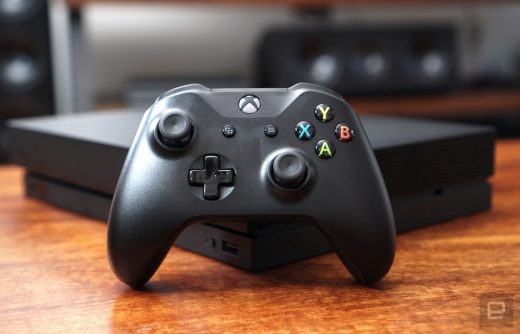Xbox One X review: A console that keeps up with gaming PCs
Pros
- Most powerful hardware ever in a home console
- Solid selection of enhanced titles
- 4K Blu-ray drive is great for movie fans
Cons
- Expensive
- Not worth it if you don’t have a 4K TV
- Still no VR support
Summary
As promised, the Xbox One X is the most powerful game console ever. In practice, though, it really just puts Microsoft on equal footing with Sony’s PlayStation 4 Pro. 4K/HDR enhanced games look great, but it’s lack of VR is disappointing in 2017.
Hardware
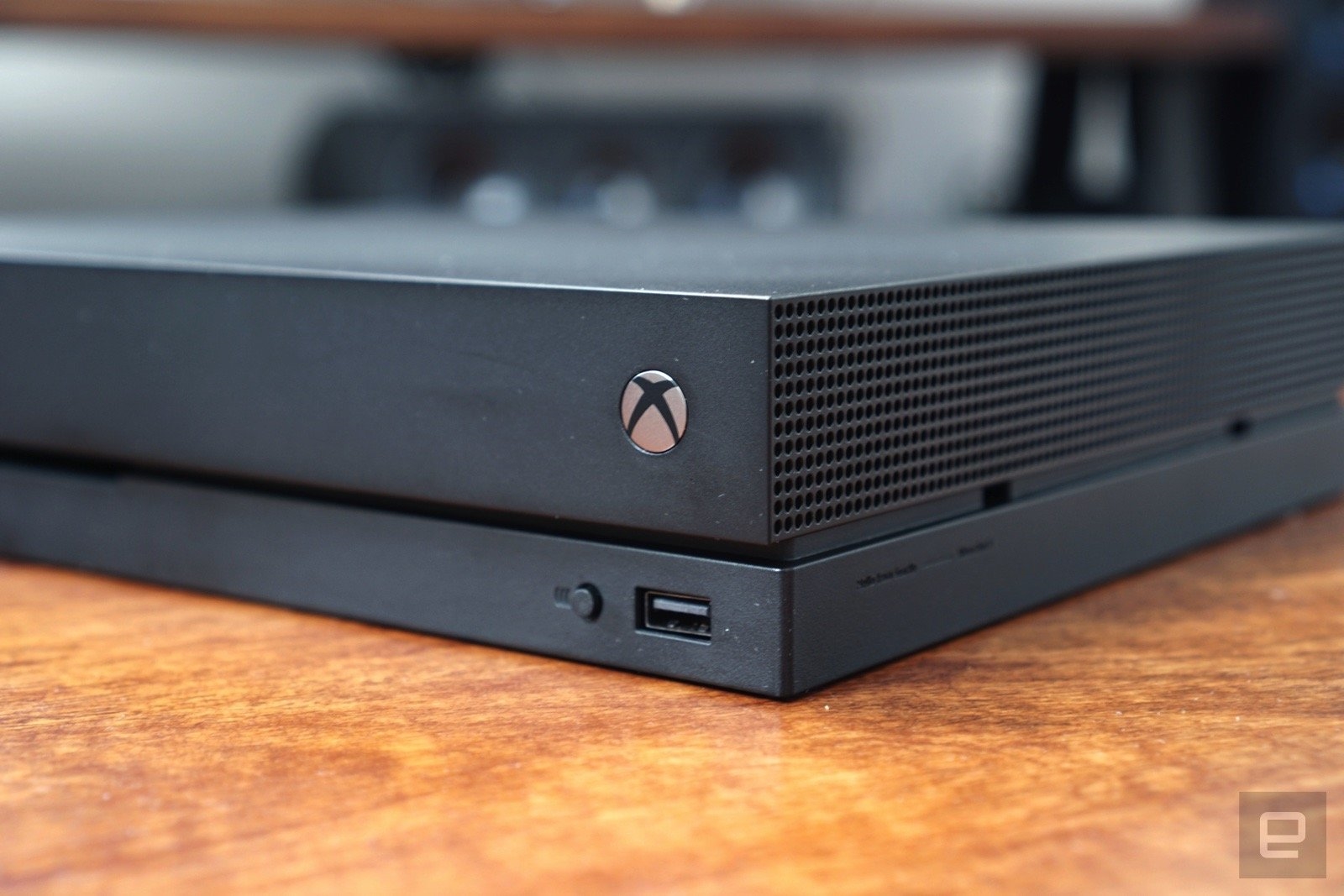
Despite all the power inside, the One X is Microsoft’s smallest console to date. It looks similar to the Xbox One S, except it has an entirely matte black case and is slightly slimmer. It’s also surprisingly dense — the console weighs 8.4 pounds, but it feels far heavier than you’d expect for its size, thanks to all of its new hardware. The One S, in comparison, weighs two pounds less.
The Xbox One X’s real upgrades are under the hood. It features an 8-core CPU running at 2.3Ghz, 12GB of GDDR5 RAM, a 1 terabyte hard drive and an upgraded AMD Polaris GPU with 6 teraflops of computing power. The PS4 Pro has only 8GB of RAM and tops out at 4.2 teraflops. Microsoft’s console is clearly faster. That additional horsepower means the Xbox One X can run more games in full native 4K than the Sony’s console.
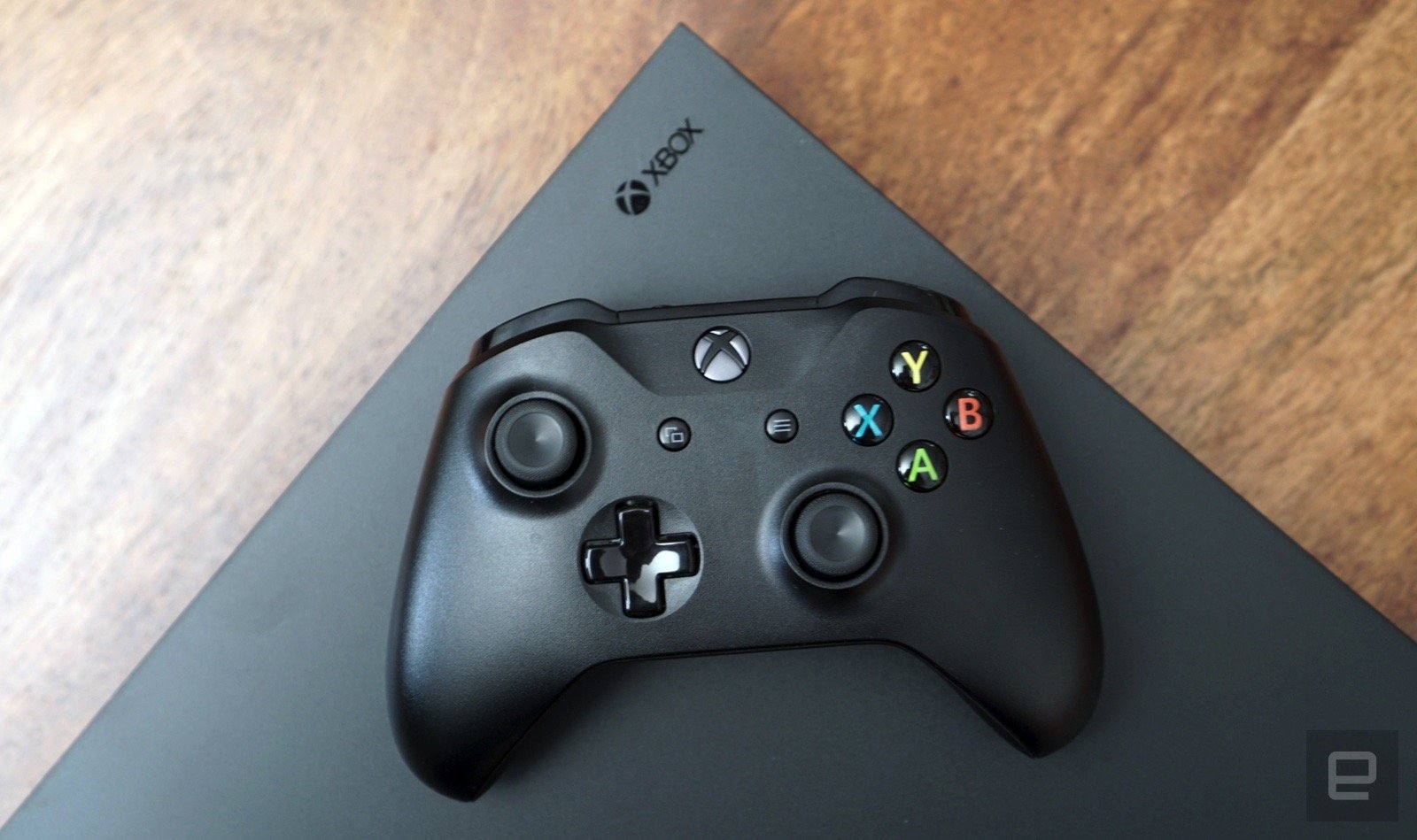
Along the front, there’s the slot-loading 4K Blu-ray drive, a physical power button, a single USB port and a controller pairing button. And around back, there are HDMI out and in ports, the latter of which lets you plug in your cable box. Additionally, there are two USB ports, connections for optical audio, IR out, and gigabit Ethernet. If you’ve still got a Kinect around, you’ll need to use a USB adapter to plug it in.
The Xbox One X is the ultimate video game system. It sports more horsepower than any system ever. And it plays more titles in native 4K than Sony’s PlayStation 4 Pro. It’s just about everything you could want without investing in a gaming PC. The only problem? It’s now been a year since the PS4 Pro launched, and the One X costs $500, while Sony’s console launched at $400. That high price limits the Xbox One X to diehard Microsoft fans who don’t mind paying a bit more to play the console’s exclusive titles in 4K. Everyone else might be better off waiting, or opting for the $279 Xbox One S.
The console’s controller hasn’t changed since its last mini-upgrade with the Xbox One S. That revision rounded out its seams, improved bumper performance and added a 3.5mm headphone jack. It’s still a great controller, though I’m annoyed Microsoft is sticking with AA batteries as their default power source. Sure, you could just pick up some renewable batteries, or the Play and Charge kit, but that’s an extra expense. And manually swapping batteries feels like a bad user experience when every other console has rechargeable controllers.
In use

You won’t find any major differences between the One X and the last Xbox at first — aside from a more dramatic startup sequence. Navigating the Xbox interface is fast and zippy, but mostly that’s due to a recent OS upgrade. If you’re moving over from an older Xbox One, you can use the backup tool to transfer your games and settings to an external hard drive. Just plug that into the new console during setup and it’ll make it feel just like your old machine. It’s also a lot faster than waiting for everything to download from Xbox Live.
You’ll still have to set aside some time if you want to play an Xbox One X-enhanced title, though. Those 4K textures will make games significantly larger, but Microsoft says it’s come up with a few ways to help developers make downloading them more efficient. For example, language packs and other optional content won’t get installed by default.
We only had a few enhanced titles to test out during our review: Gears of War 4, Killer Instinct and Super Lucky’s Tale. They each took advantage of the console in different ways. Gears of War 4 runs natively in 4K at 30 FPS with Dolby Atmos and HDR (high dynamic range lighting) support. It looked great — especially with HDR, which highlighted bright elements like lightning strikes — but I noticed the frame rate dip occasionally. I was also surprised that load times were on-par with what I’ve seen with the game on the Xbox One S.
Hardware
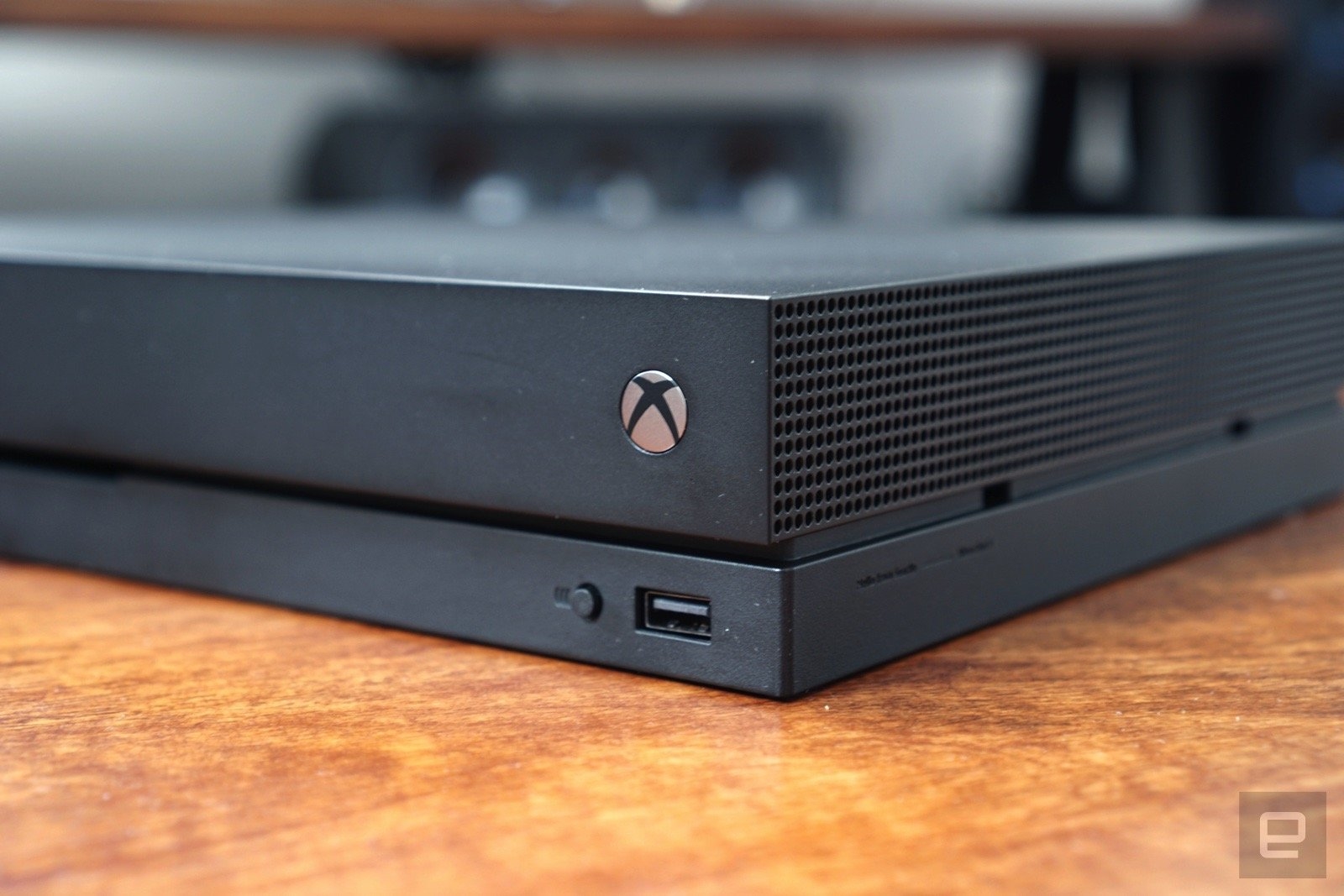
Despite all the power inside, the One X is Microsoft’s smallest console to date. It looks similar to the Xbox One S, except it has an entirely matte black case and is slightly slimmer. It’s also surprisingly dense — the console weighs 8.4 pounds, but it feels far heavier than you’d expect for its size, thanks to all of its new hardware. The One S, in comparison, weighs two pounds less.
The Xbox One X’s real upgrades are under the hood. It features an 8-core CPU running at 2.3Ghz, 12GB of GDDR5 RAM, a 1 terabyte hard drive and an upgraded AMD Polaris GPU with 6 teraflops of computing power. The PS4 Pro has only 8GB of RAM and tops out at 4.2 teraflops. Microsoft’s console is clearly faster. That additional horsepower means the Xbox One X can run more games in full native 4K than the Sony’s console.
Along the front, there’s the slot-loading 4K Blu-ray drive, a physical power button, a single USB port and a controller pairing button. And around back, there are HDMI out and in ports, the latter of which lets you plug in your cable box. Additionally, there are two USB ports, connections for optical audio, IR out, and gigabit Ethernet. If you’ve still got a Kinect around, you’ll need to use a USB adapter to plug it in.
You can also play in Performance mode, which bumps the frame rate up to 60FPS and uses higher quality graphical effects, while rendering it lower in 1080p. Personally, I preferred this, since it makes the game much smoother — as if you’re playing it on a high-end gaming PC, not a console. Some PlayStation 4 Pro games also let you choose how you wanted to distribute its power, so in some ways Microsoft is just following in its footsteps.
I’ve been playing Gears of War 4 on my gaming PC (which is connected to my home theater) over the past year, and I was impressed that the Xbox One X is able to deliver a similar experience. It didn’t quite match my rig though, which is powered by Intel Core i7 4790k CPU running at 4GHz, 16GB DDR3 RAM and an NVIDIA GTX 1080 GPU. Typically, I play at 1,440p (2,560 by 1,440 pixels) with HDR and all of the graphical settings set to their highest level, and I can easily maintain a 60FPS frame rate. The One X felt just as solid at 1080p, but there were clearly plenty of graphics settings it couldn’t take advantage of, in particular higher levels of bloom lighting and shadow detail.
Killer Instinct and Super Lucky’s Tale run in 4K at a smooth 60FPS. They both looked and played better than their standard versions, though I was surprised they didn’t take advantage of HDR. As usual, I noticed the improvement in frame rates more than the higher resolution. Unless you’re sitting very close to a TV above 50-inches, you’d likely have a hard time telling between 4K and 1080p.
That poses a problem for Microsoft: It’s betting that gamers will actually want true 4K rendering. In practice, though, PlayStation 4 Pro titles running in HDR and resolutions between 1080p and 4K often look just as good to the naked eye. The Xbox One X’s big advantage is that its hardware could let more games reach 60FPS compared to Sony’s console.
Microsoft says over 130 Xbox One X-enhanced titles are in the works. That includes already-released games like Forza Motorsport 7 and Assassin’s Creed Origins, as well as upcoming titles like Call of Duty: WW2. You’ll be able to find them easily in a special section in the Xbox store. There is also a handful of Xbox 360 games that’ll get enhanced eventually, including Halo 3 and Fallout 3. Some of those titles will get bumped up to a higher resolution, while others will get HDR support. Microsoft describes these upgrades as a bonus for developers who were prescient about how they built their games. Basically, don’t expect your entire 360 library to get enhanced.
Even if a game isn’t specifically tuned for the new console, Microsoft says you might still see some performance improvements. The PlayStation 4 Pro, meanwhile, has over one hundred games built for its hardware, and its boost mode can speed up some older games.

Microsoft is still pushing the Xbox as more than just a game console, though. 4K Blu-rays loaded up quickly, and I didn’t notice many delays as I skipped around films. Planet Earth II, in particular, looked fantastic thanks to its brilliant use of HDR. Unfortunately, the One X doesn’t support Dolby Vision, so you’re stuck with the slightly less capable HDR 10 standard. That makes sense since it’s more widely supported, but it would have been nice to see Dolby’s, too.
And speaking of Dolby technology, Microsoft is also highlighting Atmos support on the One X, just like it did with the One S. The company’s app lets you configure the console to pass audio Atmos signals to your audio receiver. You can also shell out $15 to get Atmos support for headphones, which simulates immersive surround sound. It’s strange to pay money to unlock Dolby features, but it’s worth it since it’s significantly better than Microsoft’s audio virtualization technology. The Netflix app also supports Atmos for a handful of films (something that the Xbox One S and PlayStation 4 offer, as well).
One thing you won’t find in the new Xbox is VR support. Microsoft has mentioned that the console will offer some sort of mixed reality, but it hasn’t offered up any details yet. It’s technically powerful enough to work with any of the Windows Mixed Reality headsets launching this fall. It’s a shame that Microsoft is being so wishy-washy because Sony has had a very successful head start with the PlayStation VR.
Pricing and the competition
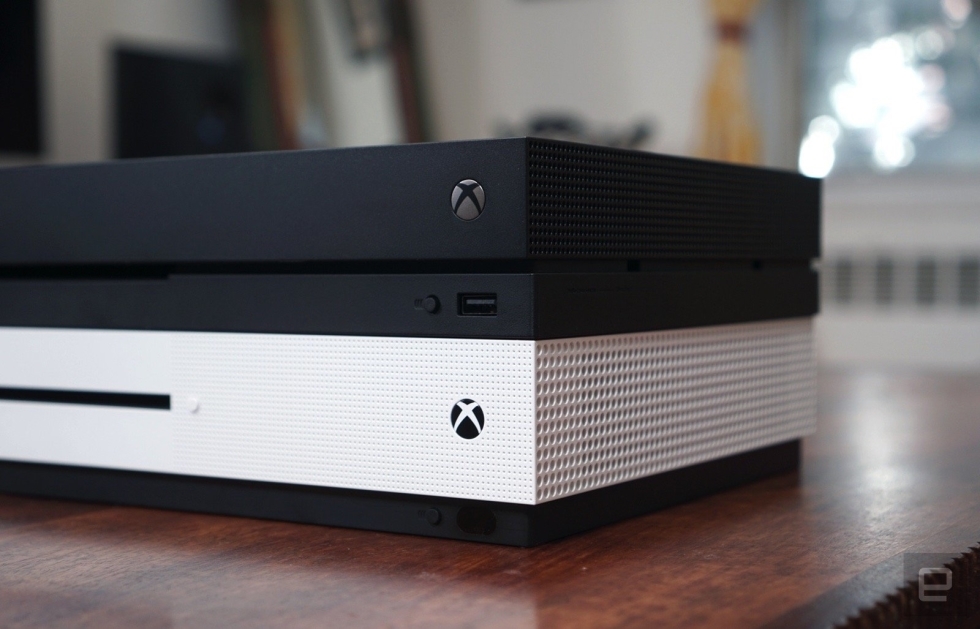
The biggest knock against the Xbox One X is its $500 price. The PS4 Pro launched at $400 last year, and there’s a good chance we’ll see plenty of deals around the holidays. If your friends are on Xbox Live, or you’re a devotee of Microsoft’s first party franchises, then the X makes more sense. If you just want to play third-party titles that come to both platforms, though, the PS4 Pro is clearly the better deal.
If you’re looking to upgrade from an original Xbox One, and you have a new TV, the One X might be more compelling. It’s faster and offers more features than the One S, and more importantly, it’ll last you much longer without needing an upgrade. There’s also plenty of wisdom in simply waiting a while before you buy the One X, especially if you haven’t moved to a 4K TV yet. The new console can make games look better on 1080p sets, since it’ll supersample high-res textures and have more graphical effects, but it’s simply not worth the upgrade since those TVs don’t support HDR.
If price isn’t a huge concern for you, it’s worth considering investing in a gaming PC. A decent one costs between $600 and $800, plus the price of a monitor, but it’ll easily be more powerful than the One X. And you have the added benefit of upgrading components down the line. Now that Microsoft and game publishers are offering most major titles on PC, you won’t be missing out on much by ditching consoles.
Wrap-up

Ultimately, the Xbox One X offers some major performance upgrades that gamers will notice — especially if you’re coming from an original Xbox One. But it’s also a bit disappointing since it’s coming a year after the PS4 Pro, and it doesn’t offer VR yet. For Microsoft fans, though, none of that will matter. It’s exactly what the company promised: the fastest game console ever made.
(109)

